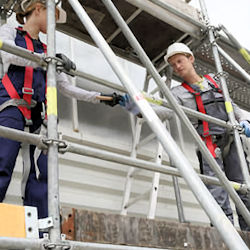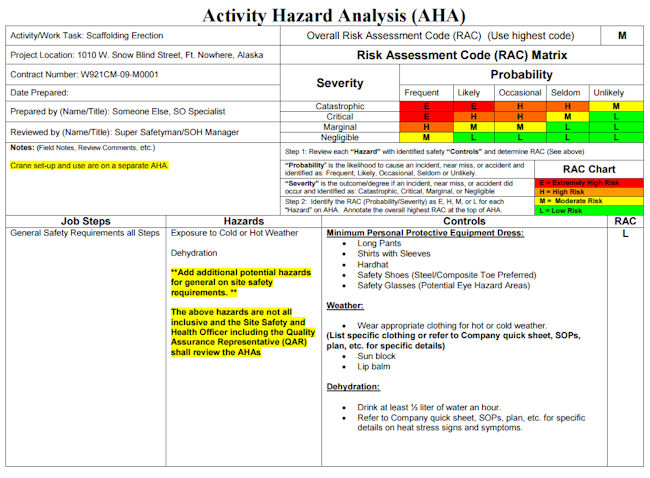SECTION 22 - WORK PLATFORMS AND SCAFFOLDING
22.A General.
This Section establishes safety requirements for the construction, operation, maintenance and use of work platforms and scaffolding used in construction alteration, demolition, operations and maintenance of buildings and other structures. It does not apply to permanently installed scaffolds or platforms.
22.A.01 Scaffolding and work platforms must be erected, used, inspected, tested, maintained, and repaired in accordance with:
- For non-mechanized equipment - ANSI A10.8, Scaffolding Safety Requirements, or the Scaffolding, Shoring, and Forming Institute's Code of Safe Practices, and the manufacturer's operating manual.
- For mechanized equipment - the manufacturer's operating manual, a copy of the manual must be available at the work site.
22.A.02 Work platforms and scaffolding must comply with fall protection (FP) and appropriate access requirements of Sections 21 and 24.
- All requirements of this Section must be applied to work platforms and means of access.
- Standard railings and handrails for stairs must be in compliance with the requirements of Sections 24.C and 24.E.
- Standard guardrails must be in compliance with Section 21.F.01.
- (1) Cross bracing is acceptable in place of a midrail when the crossing point of two braces is between 20 in (0.51 m) and 30 in (0.76 m) above the work platform.
- (2) Cross bracing is acceptable as a toprail when the crossing point of two braces is between 38 in (0.97 m) and 48 in (1.22 m) above the work platform.
- (3) The end points at each upright must be no more than 48 in (1.22 m) apart.
- (4) Cross bracing must not be used for both a midrail and top rail.
- Personal FP devices must be in compliance with Section 21.I;
- Safety (FP) nets must be in compliance with the requirements of Section 21.H.
- Ladders used to access scaffolds and work platforms must be in compliance with the requirements of this Section and Section 24.B.
22.A.03 Prior to commencing any activity that requires work in elevated areas, all provisions for access and fall protection must be delineated in the Site-Specific Fall Protection and Prevention Plan and Activity Hazard Analysis (AHA), per Section 21.D, and accepted by the GDA for the activity. For specific guidance related to erecting and disassembling scaffolds, see Section 21.K.
22.A.04 The following hierarchy and prohibitions must be followed in selecting appropriate work platforms.
- Scaffolds, platforms, or temporary floors must be provided for all work except that which can be performed safely from the ground or similar footing.
- Ladders may be used as work platforms only when allowed by Section 24.B.
- Ladder jacks, lean-to, and prop-scaffolds are prohibited.
- Emergency descent devices must not be used as working platforms.
22.A.05 Work platforms and scaffolds must not be erected or used in the immediate vicinity of power lines or electrical conductors until such are insulated, de-energized, or otherwise rendered safe against accidental contact. >See Section 11.F.
Knowledge Check Choose the best answer for the question.
22-1. Cross bracing is acceptable as a toprail when the crossing point of two braces is between _____ above the work platform.
You forgot to answer the question!


